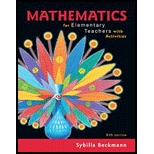
Concept explainers
Suppose that 1% of the population has a certain disease. Also suppose that there is a test for the disease, but it is not completely accurate: It has a 2% rate of false positives and a 1 % rate of false negatives. This means that the test reports that 2% of the people who don’t have the disease do have it, and the test reports that 1% of the people who do have the disease don’t have it. This problem is about the following question:
If a person tests positive for the disease, what is the probability that he or she actually has the disease?
Before you start answering the next set of questions, go back and read the beginning of the problem again. Notice that there is a difference between actually having the disease and testing positive for the disease, and there is a difference between not having the disease and testing negative for it.
a. What do you think the answer to the previous question is? (Answer without performing any calculations—just make a guess.)
b. For parts (b) through (f), suppose there is a random group of 10,000 people and all of them are tested for the disease.
Of the 10,000 people, ¡n the ideal, how many would you expect to actually have the disease and how many would you expect not to have the disease?
c. Continuing part (b), of the people from the group of 10,000 who do not have the disease, how many would you expect to test positive, in the ideal? (Give a number, not a percentage.)
d. Continuing part (b), of the people from the group of 10,000 who have the disease, how many would you expect to test positive? (Give a number, not a percentage.)
e. Using your work in parts (c) and (d), of the people from the group of 10,000, how many in total would you expect to test positive, in the ideal?
f. Using your previous work, what percent of the people who test positive for the disease should actually have the disease, in the ideal? How does this compare to your guess in part (a)? Are you surprised at the actual answer?
Want to see the full answer?
Check out a sample textbook solution
Chapter 16 Solutions
Mathematics for Elementary Teachers with Activities (5th Edition)
- Price (S) The graph below depicts a firm with market power. In the graph, MC represents the firm's marginal costs, ATC represents the average total costs, D represents demand, and MR represents marginal revenue. 110 70 60 50 40 30 20 MC ATC D 0 40 50 70 80 95 Quantity/Units MR a. At 60 units of output, how much would this profit-maximizing monopolist charge? b. How many units would it produce to maximize total revenue rather than total profit? c. What is the maximum quantity this firm can produce without incurring economic losses? d. Calculate the firm's profit at the profit-maximizing output and price. e. Why is this firm's marginal revenue curve below its demand curve? Explain.arrow_forwardA well-known company predominantly makes flat pack furniture for students. Variability with the automated machinery means the wood components are cut with a standard deviation in length of 0.45 mm. After they are cut the components are measured. If their length is more than 1.2 mm from the required length, the components are rejected. a) Calculate the percentage of components that get rejected. b) In a manufacturing run of 1000 units, how many are expected to be rejected? c) The company wishes to install more accurate equipment in order to reduce the rejection rate by one-half, using the same ±1.2mm rejection criterion. Calculate the maximum acceptable standard deviation of the new process.arrow_forwardFind the (exact) direction cosines and (rounded to 1 decimal place) direction angles of = (3,7,6)arrow_forward
- Forces of 9 pounds and 15 pounds act on each other with an angle of 72°. The magnitude of the resultant force The resultant force has an angle of pounds. * with the 9 pound force. The resultant force has an angle of with the 15 pound force. It is best to calculate each angle separately and check by seeing if they add to 72°.arrow_forward1. Sketch the following sets and determine which are domains: (a) |z−2+i| ≤ 1; - (c) Imz> 1; (e) 0≤ arg z≤ л/4 (z ± 0); Ans. (b), (c) are domains. (b) |2z+3| > 4; (d) Im z = 1; - (f) | z − 4| ≥ |z.arrow_forward8. Suppose that the moments of the random variable X are constant, that is, suppose that EX" =c for all n ≥ 1, for some constant c. Find the distribution of X.arrow_forward
- 9. The concentration function of a random variable X is defined as Qx(h) = sup P(x ≤ X ≤x+h), h>0. Show that, if X and Y are independent random variables, then Qx+y (h) min{Qx(h). Qr (h)).arrow_forward= Let (6,2,-5) and = (5,4, -6). Compute the following: บี.บี. บี. นี = 2 −4(u. v) = (-4). v= ū. (-40) (ū. v) v =arrow_forwardLet ā-6+4j- 1k and b = 7i8j+3k. Find a. b.arrow_forward
 Holt Mcdougal Larson Pre-algebra: Student Edition...AlgebraISBN:9780547587776Author:HOLT MCDOUGALPublisher:HOLT MCDOUGAL
Holt Mcdougal Larson Pre-algebra: Student Edition...AlgebraISBN:9780547587776Author:HOLT MCDOUGALPublisher:HOLT MCDOUGAL Big Ideas Math A Bridge To Success Algebra 1: Stu...AlgebraISBN:9781680331141Author:HOUGHTON MIFFLIN HARCOURTPublisher:Houghton Mifflin Harcourt
Big Ideas Math A Bridge To Success Algebra 1: Stu...AlgebraISBN:9781680331141Author:HOUGHTON MIFFLIN HARCOURTPublisher:Houghton Mifflin Harcourt Glencoe Algebra 1, Student Edition, 9780079039897...AlgebraISBN:9780079039897Author:CarterPublisher:McGraw Hill
Glencoe Algebra 1, Student Edition, 9780079039897...AlgebraISBN:9780079039897Author:CarterPublisher:McGraw Hill- Algebra & Trigonometry with Analytic GeometryAlgebraISBN:9781133382119Author:SwokowskiPublisher:Cengage



